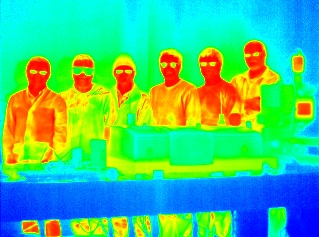Dec 19 2019
Engineers at the University of Wisconsin–Madison (UW–Madison) have developed an ultrathin coating that overturns the ever-present physics phenomenon of materials associated with thermal radiation—that is, a hotter object glows brighter.
 Taken with a long-wave infrared camera, this image of the same researchers in Kats’ lab shows distinct color variations across areas that are warmer (faces and bodies) and cooler (the table). Image Credit: Kats Group.
Taken with a long-wave infrared camera, this image of the same researchers in Kats’ lab shows distinct color variations across areas that are warmer (faces and bodies) and cooler (the table). Image Credit: Kats Group.
The novel ultrathin coating is designed from a special tunable material called samarium nickel oxide. It uses some kind of temperature trickery.
This is the first time temperature and thermal light emission have been decoupled in a solid object. We built a coating that ‘breaks’ the relationship between temperature and thermal radiation in a very particular way. Essentially, there is a temperature range within which the power of the thermal radiation emitted by our coating stays the same.
Mikhail Kats, Professor, Department of Electrical and Computer Engineering, University of Wisconsin–Madison
At present, that range of temperature is relatively small, about 105 °C–35 °C. But according to Kats, if the coating is developed further, it can be used in camouflage and heat transfer applications. Moreover, as infrared cameras turn out to be extensively available to consumers, the coating can also be used in fabrics to safeguard the personal privacy of people.
A research team including Kats, his team members, and their colleagues at Purdue University, UW–Madison, Massachusetts Institute of Technology (MIT), Harvard University, and Brookhaven National Laboratory has recently published the details of the advancement of the coating in the Proceedings of the National Academy of Sciences.
Irrespective of its temperature, the coating itself produces a set amount of thermal radiation. The reason is the coating’s emissivity—that is, the extent to which a specified material will produce light at a specified temperature—truly decreases with temperature and annuls its intrinsic radiation, stated Alireza Shahsafi, one of the lead authors of the study and a doctoral student in Kats’ laboratory.
We can imagine a future where infrared imaging is much more common, negatively impacting personal privacy. If we could cover the outside of clothing or even a vehicle with a coating of this type, an infrared camera would have a harder time distinguishing what is underneath.
Mikhail Kats, Professor, Department of Electrical and Computer Engineering, University of Wisconsin–Madison
Kats continued, “View it as an infrared privacy shield. The effect relies on changes in the optical properties of our coating due to a change in temperature. Thus, the thermal radiation of the surface is dramatically changed and can confuse an infrared camera.”
Shahsafi along with fellow members of Kats’ team demonstrated the efficacy of the coating in the laboratory. The researchers suspended a pair of samples—one was a reference piece without coating, and the other was a coated sapphire piece—from a heater, allowing a part of each sample to make contact with the heater while the remaining part was suspended in relatively cooler air.
The researchers then used an infrared camera to view both the samples and observed that the reference sapphire had a distinct temperature gradient, from intense blue to orange, pink, red, and nearly white, whereas the thermal image of the coated sapphire stayed mostly uniform.
A team effort was crucial to the success of the study. The research group of Purdue University collaborator Shriram Ramanathan produced the samarium nickel oxide and carried out comprehensive materials characterization.
Collaborators at Brookhaven National Laboratory and MIT analyzed the atomic-level behavior of the coating using the intense light of a particle-accelerating synchrotron.
Shahsafi and Patrick Roney guided the experimental work, which also led Yuzhe Xiao, a postdoctoral researcher of Kats, to write supplementary papers elucidating their highly accurate measurement methods. Roney’s employer, Sandia National Laboratory, financed his master’s degree under Kats.
A number of other students in Kats’ team characterized the coating using microscopy and other types of techniques.
Kats is the Dugald C. Jackson Faculty Scholar in Electrical and Computer Engineering at UW–Madison. Other study authors on the PNAS paper include Yuzhe Xiao, Chenghao Wan, Raymond Wambold, Jad Salman, and Zhaoning Yu from UW–Madison, You Zhou from Harvard University, Zhen Zhang from Purdue University, Jiarui Li and Riccardo Comin from MIT, and Jerzy Sadowski from Brookhaven National Laboratory.
The study was funded by grants from the Office of Naval Research (n00014-16-1-2556) and the National Science Foundation (eccs-1750341).